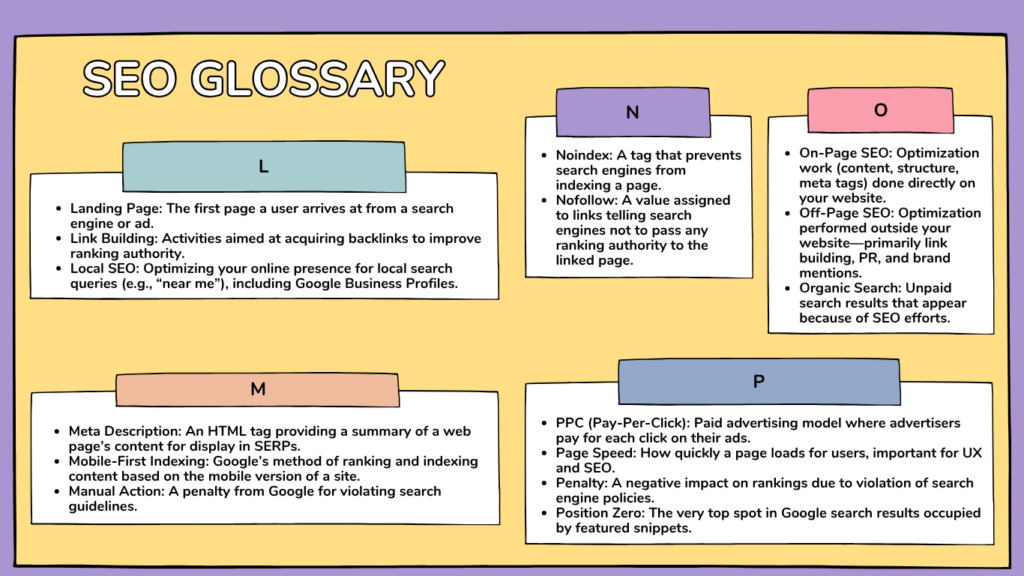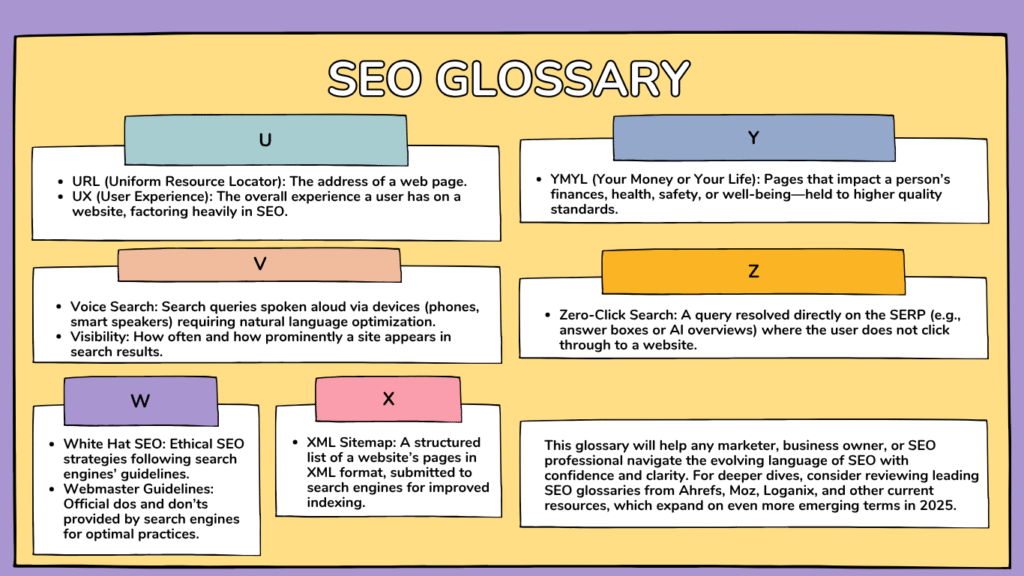August 4, 2025 | by Rayhan

This comprehensive SEO glossary explains the essential terms, acronyms, and concepts used in search engine optimization and digital marketing today. It’s organized alphabetically for easy reference and covers everything from the basics to advanced strategies.

A set of rules search engines use to rank and retrieve results for a query.
Descriptive text for images in HTML, crucial for accessibility and helping search engines understand image content.
The clickable, visible text of a hyperlink.
AI-generated search overviews now appearing in search results for many queries, offering summarized answers.
A link from an external site pointing to your website. Quality backlinks can increase authority and rankings.
Techniques that violate search engine guidelines (e.g., keyword stuffing, cloaking, spam links).
The percentage of visitors who leave a website after viewing only one page.
A search term that includes your brand name.
An HTML tag that tells search engines which version of a page is preferred to avoid duplicate content.
Showing different content to users and search engines—strictly against guidelines.
The percentage of users who complete a desired action (purchase, form fill, etc.).
Google metrics assessing site speed, responsiveness, and visual stability.
Automated software used by search engines to discover and index web content.
The percentage of users who click on a link versus those who view it.
Removal of a page from a search engine’s index.
A feature in Google Search Console to instruct Google to ignore specific backlinks.
A score predicting how well a website is likely to rank on SERPs, based on link profile and other signals.
Content that appears in more than one location online, which may harm ranking.

Experience, Expertise, Authoritativeness, Trustworthiness—key content quality factors per Google guidelines.
A hyperlink pointing from your website to another domain.
A highlighted search result box that directly answers a user query at the top of Google’s SERP.
Links located in the footer of a site, often internal but sometimes external.
Google’s tool for tracking and reporting website traffic and user behavior.
Free tool for monitoring, maintaining, and troubleshooting a site’s presence in Google Search.
New approaches for optimizing content to appear in answers/overviews generated by AI-driven search engines.
HTML tags for structuring content hierarchically (H1 is most important).
Secure protocol for website data transfer, a ranking factor.
The process by which search engines store and organize web content for retrieval.
A hyperlink from one page to another page within the same website.
Best practices for ensuring content rendered by JavaScript is discoverable and indexable by search engines.
A word or phrase targeted in SEO to attract search traffic.
The process of identifying valuable search terms for targeting.
Multiple pages on a website competing for the same keyword, potentially undermining rankings.
The overuse of keywords in content in an attempt to manipulate rankings—considered a black hat tactic.

The first page a user arrives at from a search engine or ad.
Activities aimed at acquiring backlinks to improve ranking authority.
Optimizing your online presence for local search queries (e.g., “near me”), including Google Business Profiles.
An HTML tag providing a summary of a web page’s content for display in SERPs.
Google’s method of ranking and indexing content based on the mobile version of a site.
A penalty from Google for violating search guidelines.
A tag that prevents search engines from indexing a page.
A value assigned to links telling search engines not to pass any ranking authority to the linked page.
Optimization work (content, structure, meta tags) done directly on your website.
Optimization performed outside your website—primarily link building, PR, and brand mentions.
Unpaid search results that appear because of SEO efforts.
Paid advertising model where advertisers pay for each click on their ads.
How quickly a page loads for users, important for UX and SEO.
A negative impact on rankings due to violation of search engine policies.
The very top spot in Google search results occupied by featured snippets.

Content that is original, helpful, authoritative, and satisfies search/user intent.
The word or phrase entered into a search engine by a user.
The position of a web page in search engine results.
A method of forwarding one URL to another—301 is permanent, 302 is temporary.
A file that instructs search engines which pages to crawl or ignore.
Enhanced search results including additional data (reviews, FAQs, etc.).
The effectiveness and profitability of your SEO (or other marketing) campaigns.
Code that helps search engines better understand content, improving your chance of rich results.
Automated extraction of data/content from websites.
A program (like Google or Bing) that indexes and ranks content based on queries.
Encompasses both SEO and paid search advertising (PPC).
The process of improving visibility in organic search results.
The page displaying results for a search query.
A file listing all pages on your site, aiding search engines in discovering and indexing content.
Comprehensive review of a website to identify SEO and technical issues.
Additional links displayed below a main URL in search results, directing users to important subpages.
Unsolicited, irrelevant or manipulative content or links.
Pages with insufficient or low-value content.
The HTML title of a web page, visible in browser tabs and SERPs, and a key ranking factor.
Recognition of a site or author as a trusted source on a given topic.
The visitors coming to your site.

The address of a web page.
The overall experience a user has on a website, factoring heavily in SEO.
Search queries spoken aloud via devices (phones, smart speakers) requiring natural language optimization.
How often and how prominently a site appears in search results.
Ethical SEO strategies following search engines’ guidelines.
Official dos and don’ts provided by search engines for optimal practices.
A structured list of a website’s pages in XML format, submitted to search engines for improved indexing.
Pages that impact a person’s finances, health, safety, or well-being—held to higher quality standards.
A query resolved directly on the SERP (e.g., answer boxes or AI overviews) where the user does not click through to a website.
Additional information could be found on the Google SEO starter guide!
View all